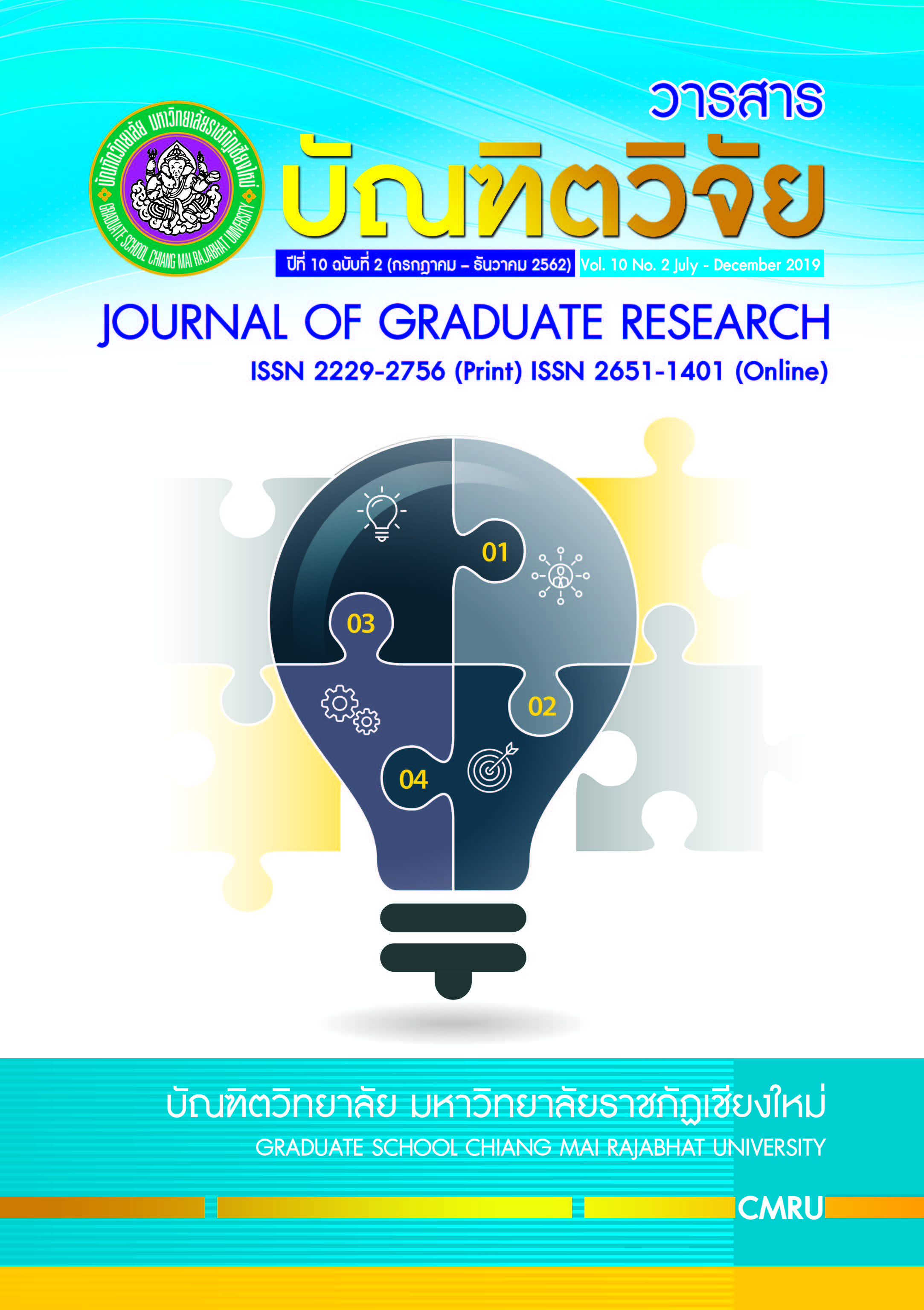Results of Integrating Academic Services with Instruction and Research in the Ci 3508 Course: A Case of “Moderate Class, More Knowledge” Activity Development Based on Local Wisdom and Learning Resources
Main Article Content
Abstract
The objective of this research was to examine the results of the integration of academic services with instruction and research: A case of “the moderate class, more knowledge” activity development based on local wisdom and learning resources. The research methodology was conducted in three dimensions. The first dimension was to explore knowledge and understanding about “the moderate class, more knowledge” activities. The second dimension was to investigate the results of the activity designs. The third dimension was to examine the satisfaction of the participating teachers, students and pupils with the implementation of the activities. The purposive sampling method was applied to select the sample group, consisting of 35 third-year-Elementary Education-major students studying in the first semester of the 2016 academic year, 30 teachers and 431 pupils. They were from three schools volunteering to participate in this research project. They included ten teachers and 181 pupils from Sueksa Songkhro Chiang Mai School, ten teachers and 87 pupils from Wat Khuang Sing School, and ten teachers and 163 pupils from Ban Pong Noi School. The research instruments consisted of the activity implementation manual, the knowledge test on implementing the activities, and the assessment on the activity designs of the students. The data were analyzed for frequency, percentage, mean, and standard deviation.
The research results revealed that the overall knowledge and understanding about the activity implementation of the students was at a very high level, with the percentage points of 87, which were higher than the pre-determined criterion of 70%. The overall quality of the activity designs of the students was at a very high level, with the mean ( ) = 4.49. The satisfaction of the teachers with the implementation of the activities was positive. Their satisfaction with the highest frequency was that the activities were fun and suitable for the ages of learners and the pupils were happy to learn from them. The overall satisfaction of the students and pupils with the activities was at the highest level ( =4.50 and 4.53).
Downloads
Article Details
References
กระทรวงศึกษาธิการ, สำนักงานคณะกรรมการการศึกษาขั้นพื้นฐาน. (2559). คู่มือบริหารจัดการเวลาเรียน
“ลดเวลาเรียน เพิ่มเวลารู้” ปีการศึกษา 2559. กรุงเทพฯ: สำนักงานคณะกรรมการการศึกษาขั้นพื้นฐาน.
กระทรวงศึกษาธิการ. (2558). คู่มือการบริหารจัดการเวลาเรียน “ลดเวลาเรียนเพิ่มเวลารู้”. สำนักวิชาการและมาตรฐานการศึกษา สำนักงานคณะกรรมการการศึกษาขั้นพื้นฐาน สืบค้นจาก
https://www.stou.ac.th/thai/grad_stdy/Masters
ขจร ตรีโสภณากร. (2558). แนวทางการบูรณาการการบริการวิชาการกับการเรียนการสอนและการวิจัย. เชียงใหม่: มหาวิทยาลัยราชภัฏเชียงใหม่.
ประวิทย์ ประมาน. (2560).รูปแบบกิจกรรมการลดเวลาเรียนเพิ่มเวลารู้ในโรงเรียนกองทุนการศึกษา จังหวัดพระนคร
ศรีอยุธยา สาขาวิชาพลศึกษา คณะครุศาสตร์ มหาวิทยาลัยราชภัฏพระนครศรีอยธุยา.วารสารวิจัยราชภัฏกรุงเก่า. 4(3), 39-46.
ปราณี อ่อนศรี และสายสมร เฉลยกิตติ. (2556). การจัดการเรียนรู้ทางการพยาบาลเพื่อสร้างความสุข : บทบาทของผู้สอนและผู้เรียน,พยาบาลทหารบก,14(1), 8-16
พัฒนา บุญญประภา สุรศักดิ์ นุ่มมีศรี และสมศักดิ์ บุญแจ้ง. (2560). การบูรณาการการจัดการศึกษาเพื่อท้องถิ่นในการแก้ปัญหามลพิษทางอากาศในชุมชน เทศบาลเมืองเมืองแกนพัฒนา จังหวัดเชียงใหม่.วารสารบัณฑิตวิจัย,8(2). 51-66.
พวงพยอม ชิดทอง และปวีณา โฆสิโต (2560). บทบาทของอาจารย์ในการส่งเสริมทักษะการเรียนรู้. พิฆเนศวร์สาร, 13(1). 1-11.
รัตนะ บัวสน. (2552). การวิจัยและพัฒนานวัตกรรมการศึกษา. กรุงเทพฯ: คำสมัย.
วิชัย ลิขิตพรรักษ์. (2559). ผลการจัดกิจกรรมในช่วงลดเวลาเรียน เพิ่มเวลารู้ตามความคิดเห็นของนักเรียนชั้นมัธยมศึกษาปีที่ 6 แผนการเรียนวิทยาศาสตร์ โรงเรียนเตรียมอุดมศึกษาในรายวิชาชีววิทยา โดยใช้รูปแบบการการจัดกิจกรรมการเรียนรู้นอกห้องเรียนเพื่อเสริมสร้างสมรรถณะการเรียนรู้ที่เน้นการพัฒนาความสามารถด้านการคิด และการพัฒนากรอบคิดแบบเปิดกว้าง (Growth Mindset). สืบค้นจาก https://www.slideshare.net/meemahidol/59-58702179
วิรัช วรรณรัตน์. (2560).ผลการดำเนินงานการจัดกิจกรรม ลดเวลาเรียนเพิ่มเวลารู้โครงการพัฒนาคุณภาพการศึกษาโดยมีมหาวิทยาลัยราชพฤกษ์เป็นพี่เลี้ยง.วารสารมนุษยศาสตร์และสังคมศาสตร์ มหาวิทยาลัยราชพฤกษ์, 3(1). 25-36.
สมปอง พะมุลิลา. (2561). การวิจัยเชิงปฏิบัติการ. [เว็บบล็อก]. สืบค้นจาก https://www.nurse.ubu.ac.th/new/?q=node/740
สายสมร เฉลยกิตติ จุฑารัตน์ บันดาลสิน กุสุมา กังหลี และพรนภา คำพราว. (2557). การศึกษาการบูรณาการบริการวิชาการกับการจัดการเรียนการสอนรายวิชาการศึกษาทั่วไปเพื่อการพัฒนามนุษย์ต่อการมีจิตอาสาและความสุขในการเรียนของนักเรียนพยาบาลชั้นปีที่ 1 วิทยาลัยพยาบาลกองทัพบก. วารสารวิทยาลัยพยาบาลกองทัพบก, 15(3), 421-429.
สุกัญญา งามบรรจง. (2559). การพัฒนารูปแบบการจัดกระบวนการเรียนรู้เพื่อเสริมสร้างทักษะในศตวรรษ ที่ 21 ผ่านกิจกรรมลดเวลาเรียนเพิ่มเวลารู้ของสํานักงานคณะกรรมการการศึกษาขั้นพื้นฐาน. กรุงเทพฯ: สํานักงานคณะกรรมการการศึกษาขั้นพื้นฐาน กระทรวงศึกษาธิการ.
สุธิดา ศรีปลั่ง ณัฐกานต์ ภาคพรต และกาญจนา บุญส่ง. (2559 ). การประเมินการบริหารโครงการ “ลดเวลาเรียน เพิ่มเวลารู้” ของโรงเรียนนำร่อง สังกัดสำนักงานเขตพื้นที่การศึกษาประถมศึกษาเพชรบุรี เขต 1. ในเอกสาร การประชุมเสนอผลงานวิจัยระดับชาติ มหาวิทยาลัยสุโขทัยธรรมาธิราช ครั้งที่ 6, ณ มหาวิทยาลัย สุโขทัยธรรมาธิราช 25 พฤศจิกายน 2559 (น.1-9).นนทบุรี: มหาวิทยาลัยสุโขทัยธรรมาธิราช.
สำนักงานคณะกรรมการการอุดมศึกษา. (2558). คู่มือการประกันคุณภาพการศึกษาภายใน ระดับอุดมศึกษา พ.ศ. 2557. กรุงเทพฯ: ห้างหุ้นส่วนจำกัด ภาพพิมพ์.


